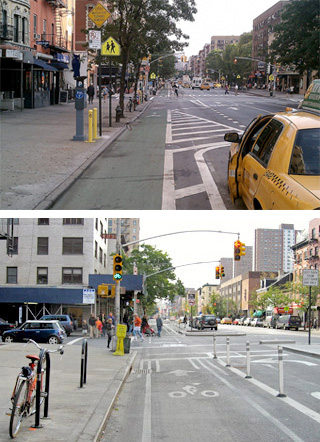Manhattan CB4 Wants the Full Safety Treatment for Eighth Ave Bike Lane
Last night Manhattan Community Board 4 voted unanimously in favor of an 11-block extension for the Eighth Avenue bike lane, which would bring the protected bikeway up to 34th Street. In an interesting flourish, the board asked that the extension include separate left-turn phases for bikes and cars.
 Top: Left-turn zone on Second Avenue. (Photo: John Del Signore/Gothamist) Bottom: The separate left-turn signals and pedestrian refuge on Ninth Avenue. (Photo: NYCDOT)
Top: Left-turn zone on Second Avenue. (Photo: John Del Signore/Gothamist) Bottom: The separate left-turn signals and pedestrian refuge on Ninth Avenue. (Photo: NYCDOT)The request for separate turn signals calls attention to design differences that have become increasingly pronounced among the city’s protected bike lanes. NYC’s first protected bikeway, on Ninth Avenue, came with pedestrian refuges at every intersection and separate left-turn signals for bikes and cars. The design has worked so well that City Council Speaker Christine Quinn and transportation committee chair James Vacca used Ninth Avenue as the backdrop for a press event in support of complete streets policies earlier this year.
The new bike lanes on First and Second Avenues, as well as the lane coming to Columbus Avenue later this year, don’t include separate turn phases or concrete pedestrian refuges at many intersections. The lack of these features may water down the safety benefits of the new lanes.
On a recent tour of the separated bikeways in the East Village, CB4 transportation committee co-chair Christine Berthet says she saw drivers routinely take left turns without using the designated "mixing zones" — the areas where motorists are supposed to merge with bike traffic before turning. "Cars are turning from the second lane at full speed," she said. "The [bike] lane is not designated by something physical."
As with any new design, motorists may need some time to adjust their behavior, but Berthet and other street safety advocates think it’s poor strategy to settle for less than the full bike-ped package. "Fundamentally, I think we do not want to encourage DOT to proceed with
bike lanes that are just paint, especially at the turning corner, where
it’s dangerous for everyone," she said.
On Eighth Avenue, DOT has committed to installing ped refuges at every
intersection except where there are left turns. Berthet says that so
far, the agency has rejected the idea of separate turn signals.
She wants to see the left-turn zones separated, "at a minimum," by
plastic bollards.
Lanes that can be laid down with just paint do have the benefit of fast and inexpensive implementation. And we know from the results on Grand Street that a protected bikeway with
no ped refuges can still make the street safer for everyone, including pedestrians and motorists.
But there’s much more asphalt to walk across on Manhattan avenues than on Grand Street, and without those pedestrian refuges sticking out of the pavement, giving people on foot a space of their own, the shared interests of cyclists and pedestrians won’t be quite so apparent.





